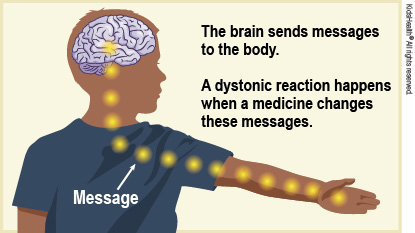After a Dystonic Reaction: How to Care for Your Child
A dystonic reaction is a rare side effect to a medicine. It happens because the medicine causes chemicals in the brain to get out of balance. The imbalance changes the messages that the brain sends to the muscles. This can cause the muscles to spasm (stiffen or cramp). Dystonic reactions don't usually lead to lasting problems. It is important to follow the doctor's recommendations about which medicines are OK for your child.


-
Give all prescribed medicines as directed.
-
Ask your doctor when your child can return to normal activities.
-
A dystonic reaction can be scary for a child. Explain what happened and comfort your child.
-
Make any follow-up appointments as directed by the doctor.
-
Tell all your child's doctors about the dystonic reaction and the medicine that caused it.



What medicines can cause dystonic reactions? Dystonic reactions can be caused by some medicines that kids might take for nausea and vomiting, seizures, or psychiatric illness (such as depression or psychotic disorders). Some drugs (like cocaine or ecstasy) also can cause dystonic reactions.
What happens during a dystonic reaction? Dystonic reactions often involve muscles of the face or neck, but they can also affect the arms or legs. A child having a dystonic reaction has a hard time controlling their muscles. Parts of the body may twist into unusual positions. They might have trouble speaking or swallowing, or they may make strange movements with their eyes or tongue. Rarely, spasm can happen in the throat and lead to trouble breathing. Dystonic reactions can be painful and very upsetting.
Kids, teens, and young adults are more likely to have a dystonic reaction than older adults. Signs can start soon after taking the medicine or may not start for hours or days.
How are dystonic reactions treated? Health care providers treat dystonic reactions with medicines that relax the muscles. They often give these with a needle into a vein or into the muscle so it can start helping right away. Sometimes the medicine is given by mouth. Usually, a dystonic reaction gets better soon after the child gets the medicine. Because the dystonic reaction can come back, your child may need to take medicines by mouth at home for the next few days. Health care providers usually recommend a child stop taking any medicine that causes a dystonic reaction. Sometimes a different medicine is prescribed instead. Rarely, a child will keep taking the medicine and get other prescribed medicines to prevent another dystonic reaction.